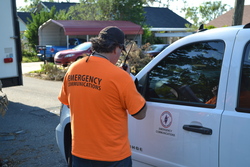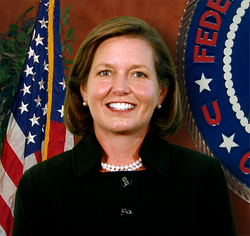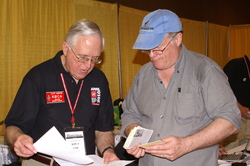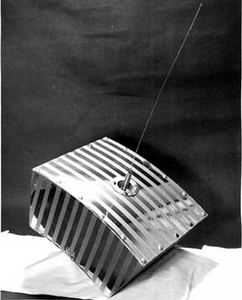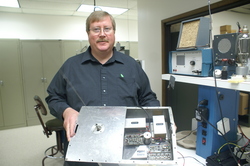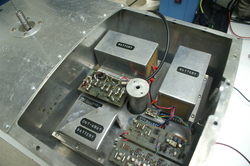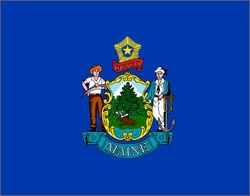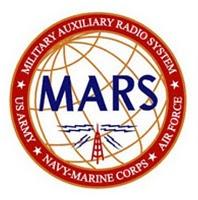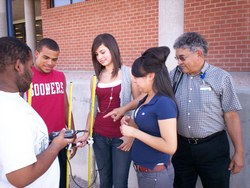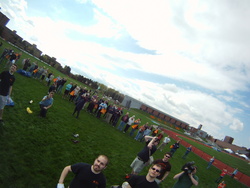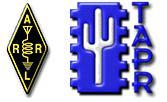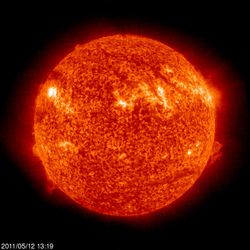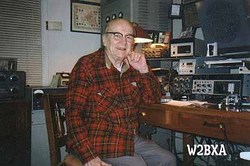 May 12, 2011 John E. Ross, KD8IDJ, Editor
| ||||||||||||||
+ Available on ARRL Audio News + Public Service: As Weather Clears in Southeast, Hams Continue to Provide Support Even though the storms that raged through the Southeast have long gone, the damage and heartache they left in their wake are still present. In Alabama, the state that felt the biggest brunt of the storms, hams made their way to fire stations, emergency operations centers and shelters -- anywhere they were told that they were needed.
Calling it his first experience with an EF-5 tornado, ARRL Southeastern Division Director Greg Sarratt, W4OZK, said that the devastation is "mind-boggling! ARES® successfully provided a massive amount of critical communications, got repeaters back on the air, with no utility power. It took five days before significant utility power was restored; my power was restored on the evening of Day Six. ARES® has gone above and beyond in supporting multiple government and not-government organizations and conducting many other tasks, all at once. ARES® works!" Read more here. FCC Commissioner Meredith Attwell Baker to Leave FCC in June
On May 12, FCC Commissioner Meredith Attwell Baker announced that she would be leaving her post on June 3 -- just 27 days before her term expires -- creating a Republican vacancy on the Commission. Chairman Julius Genachowski, along with Commissioners Michael Copps and Mignon Clyburn, are Democrats, while Commissioner Robert McDowell is a Republican. Only three sitting Commissioners may be of the same political party. Baker was nominated by President Barack Obama on June 25, 2009 and sworn in just five weeks later. She filled the unexpired term of fellow Republican and former Chairman Kevin J. Martin, who resigned in January 2009; her term is set to expire June 30, 2011. Baker will join Comcast as its Senior Vice President of Government Affairs, NBCUniversal. "I've been privileged to serve in government for the past seven years under President Obama at the FCC and President [George W.] Bush at NTIA," she said in a statement released by Comcast. "I'm excited to embark on a new phase of my career with Comcast and NBCUniversal." Read more here. + ARRL EXPO at the Dayton Hamvention®: Where the DX Comes to You!
ARRL Membership and Volunteer Programs Manager Dave Patton, NN1N, reports that plans for a plethora of DX activities at the ARRL EXPO -- part of the 2011 Dayton Hamvention® -- are wrapping up. "We are excited about the activities that will be taking place," he said. "Visitors to the EXPO will see a lot of activities relating to DX, including DXCC card checking, a chance to drop off QSL cards for the ARRL Outgoing QSL Bureau and even an expanded International Amateur Radio Union area." The Dayton Hamvention will take place May 20-22 at Hara Arena, located near Dayton, Ohio. Read more here. + Amateur Radio in Space: Celebrating 50 Years of OSCAR I and Amateur Radio Satellites By ARRL News Editor S. Khrystyne Keane, K1SFA 1961. It was the middle of the Cold War. John F. Kennedy is inaugurated as the 35th President of the United States. The Bay of Pigs invasion fails in Cuba. The Beatles perform for the first time at the Cavern Club in Liverpool. Freedom Riders are arrested in Jackson, Mississippi for "disturbing the peace" after disembarking from their bus. Construction of the Berlin Wall begins. Roger Maris of the New York Yankees hits his 61st home run in the last game of the season, beating the 34 year old record held by Babe Ruth. Barbie gets a boyfriend when Mattel introduces the Ken doll.
Just four years earlier, the Soviet Union had launched Sputnik I, the first human-made object to orbit the Earth, ushering in the Space Age. For the next 30 years, the Cold War rivalry between the US and the former Soviet Union focused on attaining firsts in space exploration. These were seen as necessary for national security and symbolic of technological and ideological superiority. The "space race" involved pioneering efforts to launch artificial satellites, sub-orbital and orbital human spaceflight around the Earth, as well as piloted voyages to the Moon. 1961. Mercury-Redstone 2 launches into space carrying Ham the Chimp. Soviet cosmonaut Yuri Gagarin becomes the first human in space. Alan Shepard becomes the first American in space aboard Mercury-Redstone 3. Gus Grissom, piloting the Mercury-Redstone 4 capsule Liberty Bell 7, becomes the second American to go into space. OSCAR I -- Orbiting Satellite Carrying Amateur Radio -- the very first Amateur Radio satellite, is launched into space.
Barely four months after the successful launch of Sputnik I, the United States launches the unmanned Explorer I on January 31, 1958. At about that same time, a group of hams on the West Coast -- Lance Ginner, K6GSJ; Chuck Smallhouse, W6MGZ; Ed Beck, K6ZX; Al Diem; Chuck Townes, K6LFH (SK), and Nick Marshall, W6OLO (SK) -- begin toying with the idea of launching an Amateur Radio satellite into orbit and organized themselves into Project OSCAR. After a series of high level exchanges among Project OSCAR members, the ARRL and the US Air Force, a launch opportunity on a Thor DM-21 Agena-B rocket from Vandenberg Air Force Base in California was secured for the very first Amateur Radio satellite: OSCAR I. It was successfully launched into a low Earth orbit on the morning of December 12, 1961 -- four years after the launch of Sputnik I. The satellite was also the world's first non-government bird. Fifty years -- 1961 to 2011 -- is a long time -- and an important milestone, thought ARRL Lab Test Engineer Bob Allison, WB1GCM. And then he had a lightbulb moment: Why not take the back-up OSCAR I on display at ARRL Headquarters and make it work again? So W1AW Station Manager Joe Carcia, NJ1Q and Allison began tinkering with the satellite, one of three made by Project OSCAR. One of the satellites went up into space in 1961, one is on display at the Smithsonian Air and Space Museum in Washington, DC and the other was until recently sitting in a display case on the first floor of the HQ building in Newington.
After much trial and error, Carcia finally got OSCAR I to transmit a signal on 145 MHz, just as the original satellite did. "Since specific technical literature on the satellite was unavailable, information taken from 1962 QST and CQ articles assisted in the reconstruction of the transmitter in the ARRL unit," Carcia explained. "Much care was given to salvage the original components, although time had taken its toll on most of the circuitry. As such, although the transmitter functions, the actual keying of the transmitter is performed using a PIC beacon keyer. Power is supplied using a standard wall-cube providing 12 V dc." In honor of OSCAR I's 50th anniversary, the rebuilt satellite will be on display at the ARRL EXPO area at the Dayton Hamvention, May 20-22 at Hara Arena in Trotwood, Ohio. "We have hooked OSCAR I up to a dummy load running very low power, and as you walk by, you will hear it transmit "HI HI," just as the original OSCAR did 50 years ago," Allison said. Since the transmission does not identify, you won't be able to pick it up on your handheld transceiver while at Hara. Read more here. + Honoring Amateur Radio: Maine Honors Hams on World Amateur Radio Day
In a joint resolution released on April 14, the Maine House and Senate recognized the nearly 5000 licensed ham radio operators in Maine and their service to the state. The resolution proclaimed April 18 Amateur Radio Day in the state. April 18 was also World Amateur Radio Day, marking the 86th anniversary of the founding of International Amateur Radio Union. Read more here. + On the Air: Annual Armed Forces Day Crossband Test Scheduled for May 14
The Army, Air Force, Navy, Marine Corps and Coast Guard are co-sponsoring the annual Military/Amateur Radio Crossband Communications Test in celebration of the 61st anniversary of Armed Forces Day ( AFD). Although the actual Armed Forces Day is celebrated on the third Saturday in May -- May 21 in 2011 -- the AFD Military/Amateur Crossband Communications Test will be conducted on May 14 to prevent conflict with the Dayton Hamvention®, scheduled for May 20-22. Read more here. Amateur Radio in the Classroom: High School Radio Club to Offer Free Foxhunting Transmitter Kits
Miguel Enriquez, KD7RPP, is an Instructor with the ARRL's Teachers Institute on Wireless Technology, as well as a math and electronics teacher at Pueblo High School in Tucson, Arizona. One of his responsibilities at Pueblo is advising the school's Amateur Radio club. "Our radio club has discovered how much fun ham radio can be as a way to improve the math, science, technology and communications skills of the students," he told the ARRL. "We are also fortunate that the ARRL has been generous in providing us with equipment, materials, supplies and curricula. Without their support, we would not currently be involved in building QRP transceivers, ATV downconverters for our Amateur Television station (W7ATN), underwater robots for mapping lakes recently discovered in caves in the Southwest -- and fox hunt transmitters." Read more here. Amateur Radio in the Classroom: RIT Students Successfully Launch High Altitude Balloon
The Rochester Institute of Technology Amateur Radio Club, K2GXT, had a successful launch of RITCHIE-1 -- a custom high altitude balloon designed by members of K2GXT -- at the Imagine RIT Festival on May 7. According to RITARC Vice President Bryce Salmi, KB1LQC, the goal of the launch was not to reach high altitudes to take images, but to engineer a reliable, modular and reusable payload with good engineering practice. "Saturday's launch went perfect," Salmi told the ARRL. "The launch was streamed live to the Internet and a local television station even produced a segment for their newscast on it." The club won the Academic Award for the balloon at the festival. Read more here. 2011 ARRL/TAPR Digital Communications Conference Call for Papers
Technical papers are solicited for presentation at the 30th Annual ARRL/TAPR Digital Communications Conference, to be held September 16-18 in Baltimore, Maryland. Papers will also be published in the Conference Proceedings. Authors do not need to attend the conference to have their papers included in the Proceedings. The submission deadline is July 31, 2011. Read more here. Solar Update
Tad " The Sun ain't gonna shine anymore" Cook, K7RA, reports: Currently, we can see six sunspot groups. A new one appeared May 5, then two more on May 8, another two on May 9 and another new one on May 11. The average sunspot number for this week rose nearly 7 points to 74.6 and geomagnetic conditions were quiet all week. But the latest forecast shows unsettled geomagnetic conditions on Thursday (today) with a planetary A index of 15, then 10, 5, 8, 8 and 10 on May 13-17, then 5 on May 18-25. Solar flux values of 95 are predicted for May 12-17, 100 and 105 on May 18-19 and 110 on May 20-30. NASA had an updated prediction for the peak of Solar Cycle 24 on May 9, and it is 7 points higher -- and one month earlier -- than the April 4 prediction. On April 4, NASA predicted the smallest cycle in 200 years, with a peak smoothed sunspot number of 62 in July 2013. This month, that estimate has been raised to 69, and the peak moved forward one month to June 2013. NASA now says this will likely be the smallest cycle in 100 years, instead of 200. Look for more information on the ARRL website on Friday, May 13. For more information concerning radio propagation, visit the ARRL Technical Information Service Propagation page. This week's "Tad Cookism" is brought to you by the Walker Brothers' The Sun Ain't Gonna Shine Anymore. + Silent Key: Noted DXer Ben Stevenson, W2BXA (SK)
Ben Stevenson, W2BXA, of Colonia, New Jersey, passed away on May 5, 2011. He was 97. An ARRL member since 1934, Stevenson was also a charter member of the North Jersey DX Association (NJDXA) since 1957, serving as its first president. Stevenson held Satellite DXCC #1, Mixed DXCC #6 (390 countries confirmed) and Phone DXCC #6 (388 countries confirmed). Read more here. This Week on the Radio This week:
Next week:
All dates, unless otherwise stated, are UTC. See the ARRL Contest Branch page, the ARRL Contest Update and the WA7BNM Contest Calendar for more info. Looking for a Special Event station? Be sure to check out the ARRL Special Event Stations Web page. Upcoming ARRL Section, State and Division Conventions and Events
To find a convention or hamfest near you, click here. ARRL -- Your One-Stop Resource for Amateur Radio News and Information Join or Renew Today! ARRL membership includes QST, Amateur Radio's most popular and informative journal, delivered to your mailbox each month. Subscribe to NCJ -- the National Contest Journal. Published bi-monthly, features articles by top contesters, letters, hints, statistics, scores, NA Sprint and QSO Parties. Subscribe to QEX -- A Forum for Communications Experimenters. Published bi-monthly, features technical articles, construction projects, columns and other items of interest to radio amateurs and communications professionals. Free of charge to ARRL members: Subscribe to the ARES E-Letter (monthly public service and emergency communications news), the ARRL Contest Update (bi-weekly contest newsletter), Division and Section news alerts -- and much more! Find us on Facebook! ARRL offers a wide array of products to enhance your enjoyment of Amateur Radio Donate to the fund of your choice -- support programs not funded by member dues! Click here to advertise in this newsletter. | ||||||||||||||
